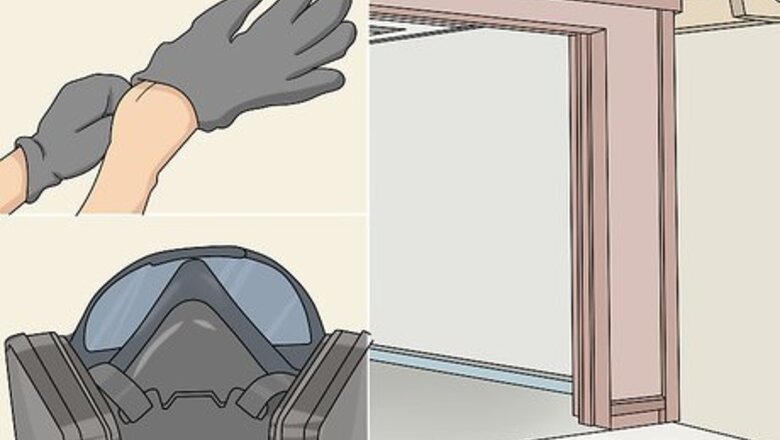
views
Cleaning and Sanding the Pipes
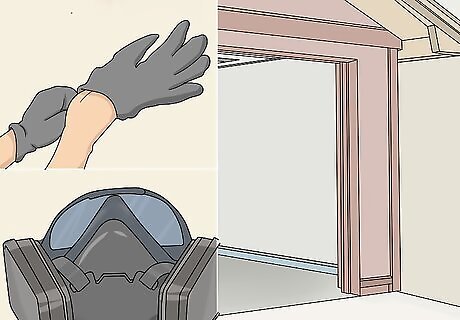
Put on gloves and a respirator mask, then ventilate the area. Always wear a well-fitting respirator mask complete with a disposable filtration cartridge when painting in an enclosed space. You can get a disposable mask with a particulate filter or a full spray paint respirator with replaceable cartridges on the side. Fit the mask over your mouth, then open up any nearby doors and windows to help ventilate paint fumes. Also, have a pair of rubber gloves on hand to use when cleaning the pipes. If you are able to, paint the pipes before using them in a project. That way, they are easier to work with and can be painted outdoors. Keep other people and pets out of the area until you’re done painting.
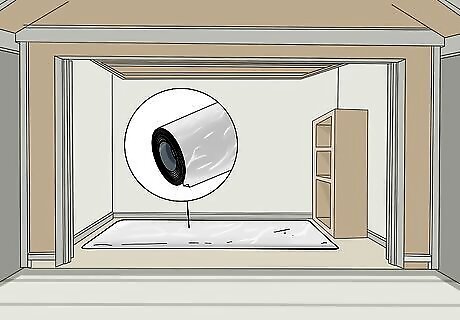
Spread plastic sheets across the floor and nearby walls. Painting gets messy, especially when you’re trying to finish a pipe installed in a tight spot. Purchase some plastic tarps or drop cloths. Set one underneath the pipe, then use painter’s tape to apply the remaining sheets on any nearby walls. Plastic sheets are available online and at hardware stores as well. If you don’t have sheeting, you could use old newspaper instead. New, uninstalled pipes are easier to work with than ones that have already been installed. Rest the pipe against a covered surface or stand it up on a post, for example.
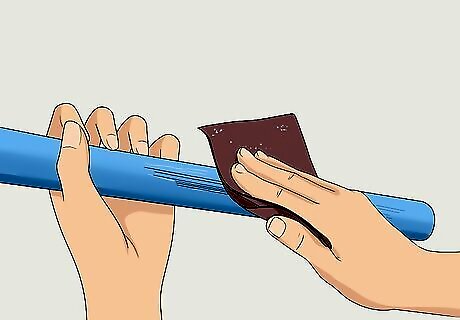
Rub the pipe gently with 220-grit sandpaper. Treat the entire outer part of the pipe to prepare it for painting. Start at one end and work your way toward the other. Scrub in a circular motion with a light but firm amount of pressure. PVC is soft, so be gentle with it, but apply a little more force to remove rust and other debris from metal. Treat PVC pipes by hand. Electric sanders are too strong and will wear out PVC but can be used on metal pipes. PVC pipes will leave wax on the sandpaper over time, making it unusable. Have multiple pieces of sandpaper on hand and switch sheets when this happens. If metal pipes have rusted badly, remove as much of the rust as possible. Then, apply a rust converter primer to create a stable base for the paint. If the pipes have already been installed, use a sanding block for an easier time rubbing down tough to reach spots.
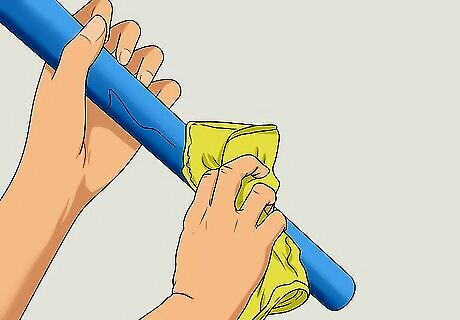
Wipe the pipe clean with a moist towel to remove debris. Dampen a rag in a little bit of cold water, checking to make sure it isn’t dripping. Then, scrub the entire pipe from top to bottom. Check again for dirty spots afterward. Try mixing 1 US tbsp (15 mL) of dish soap into warm water and scrubbing the pipe a second time to eliminate the remaining debris. To clear stubborn debris on PVC, use acetone. Wear gloves and a mask while handling it. You could also use an ammonia-based cleaner such as a glass cleaner. If you’re struggling to remove rust, spread a rust remover onto the pipe with a clean sponge or brush. Let the rust remover soak into the pipe for about 20 minutes before rinsing it off with a damp, clean rag.
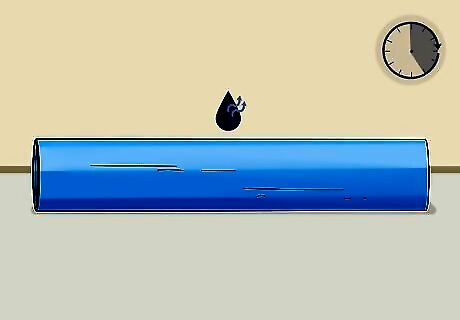
Wait about 20 minutes for the pipe to dry. The pipe will dry on its own, but the exact amount of time it needs can vary depending on where you’re at. It dries faster on warm days and when it’s in an area with good air circulation. Leave it outside if you can, and give it a little extra time if it’s already installed in an enclosed space. Make sure it feels dry to the touch before attempting to paint it. Any moisture left on the pipe could stop the paint from sticking to it. If the pipe doesn’t seem ready yet, don’t rush it! You could also wipe the pipe dry with a clean, soft cloth. That way, you don’t have to wait as long for it to dry on its own.
Applying Paint to PVC Pipes
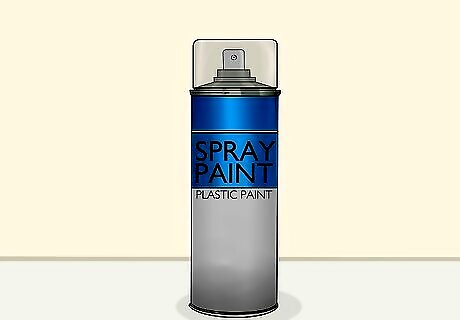
Choose a spray paint labeled for use on plastic surfaces. The only way to color PVC is to get a specific PVC spray paint. This type of paint often has a label like “plastic paint,” “for plastic,” or something similar. Before selecting a paint, check the label to ensure it’s compatible with PVC. The same traits that make PVC pipes unique also cause them to resist most types of paint. You can buy plastic paint online or at most hardware stores. You won’t need to get a plastic paint primer, but you could use an acrylic or latex stain-blocking primer if you wish. PVC is designed to resist moisture, so standard paint doesn’t stick to it.
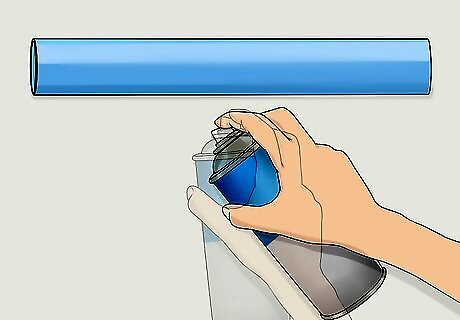
Sweep the paint canister from side to side to begin spraying the pipe. Shake the can of spray paint for 20 seconds to activate it. Then, hold it about 6 in (15 cm) from the pipe. Start at the top of the pipe and work all the way across it. Move the can at a slow but steady pace to cover it consistently. If the pipes haven’t been installed yet, paint them in an open space. It’s better to stand them up on a wood dowel, post, or something else that allows you to reach both sides. If you’re having trouble reaching behind installed PVC pipes, try spraying extra paint onto it. Then, use a brush to spread the paint to the back. Getting a good coating is tough to do without removing the pipe. Spraying at the correct speed can be tricky at first. To find the ideal speed, you could practice spraying cardboard or another piece of scrap material.
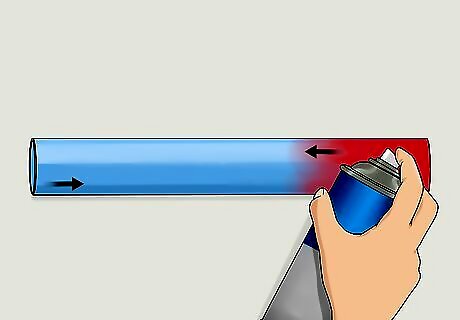
Coat the pipe by working from top to bottom. When you reach the front part of the pipe, move the canister down to an uncovered portion. Take care to avoid overlapping any areas you have already painted. Keep working your way down the pipe until you finish it. To make the painting process easier, you may want to focus on one side at first. After it dries, flip the pipe over to paint the opposite side.
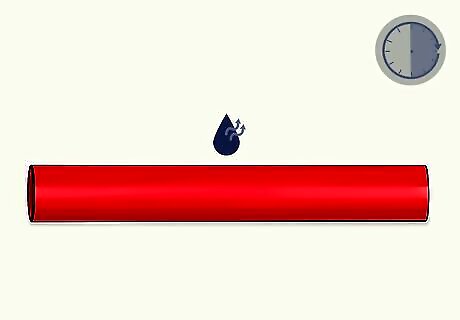
Wait 20 to 30 minutes for the paint to dry. Leave the pipe alone, making sure nothing touches the wet paint in the meantime. The paint dries relatively quickly in ideal conditions. Its surface will develop a thin layer that feels sticky to the touch as it surface dries. The paint won’t be fully cured at this point, so keep the pipe away from moisture and other possible sources of damage. Be sure to consult the manufacturer’s instructions for a more specific recommendation on how long to let the paint dry. It can vary a little depending on the brand you buy.
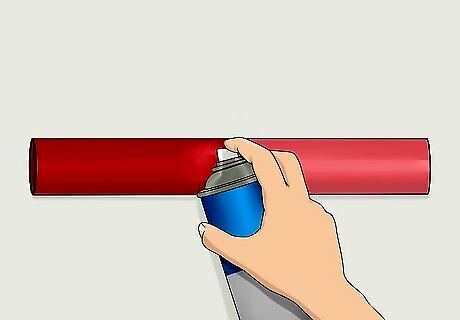
Add extra layers of paint, letting each one dry between coats. Your pipe probably won’t look consistent and colorful right away. Most projects require at least a second layer of paint. After finishing the second layer, let it dry, then check the finish again. Add a third layer if you aren't satisfied with the finish. Remember to keep each coat of paint light and even. Make sure you don’t overlap areas you have already covered, and flip the pipe carefully if you need to in order to finish the opposite side.
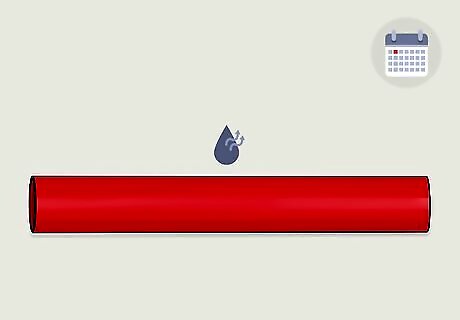
Give the paint at least 24 hours to dry. If you are able to, leave the pipe in a safe location with good air circulation. Otherwise, make sure the pipe is undisturbed until it finishes drying. Let other people in your home know not to touch it. Remember to check the manufacturer’s instructions to see exactly how much time the paint needs to cure. Heat, moisture, and physical contact can affect the finish if the paint hasn’t cured. If you’re working with uninstalled PVC, let it dry before attempting to connect it to anything. Existing pipes are safe to use as long as you avoid damage to the finish.
Covering Metal Pipes with Paint
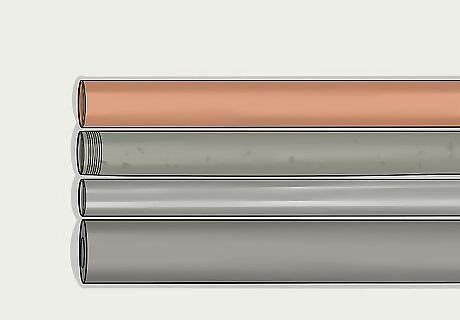
Check the color and weight of the pipe to find out what it is made of. Metal pipes are usually either copper or galvanized steel, although they can be made with other types of metal. Each metal has some specific traits you can spot by close inspection. Note the pipe’s color, then touch it, picking it up if it isn’t already installed. Look for discolorations or other identifying markers. Use this information to choose a compatible paint or primer. Copper pipes are often used in plumbing. They have an orange color similar to a penny and can turn green over time. Galvanized steel is also used in plumbing. Steel pipes feel somewhat heavy and are a dull gray color. Iron is similar and can be painted the same way. Aluminum pipes look similar to steel ones but have a much shinier, silvery color. If you pick up an aluminum pipe, it feels very light. Lead pipes feel very heavy compared to steel. They tend to be a dark gray color and are easy to scratch. Lead isn’t magnetic, which you can test with a kitchen magnet.
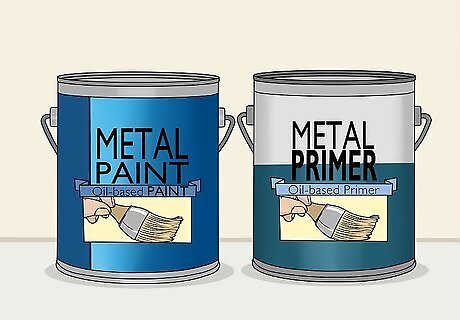
Select an enamel or oil-based metal paint and primer. Metal pipes require a specific type of paint that seals it against rust. To get the paint to stick to the metal, you also have to apply a compatible primer. Make sure both products are compatible with the type of pipe you’re painting. Generally, metal paint and primer comes in both spray-on and paint-on varieties that work on almost any type of metal surface. Oil-based paints and primers are more resistant to stains and damage. Enamel and acrylic products are both oil-based, so they still work well with metal. Enamel self-etching primers work very well on aluminum or any bare surfaces. It’s good for smoothing out rough surfaces for a very consistent finish. If you’re painting over rust you cannot remove, make sure you’re using a rust converter primer or else the paint won’t stick. Look for a primer that is labeled as a rust converter. Spray-on products are useful for covering tight spaces. If you don’t have to deal with hard-to-reach spots, use a paint-on version for a quicker and more consistent finish.
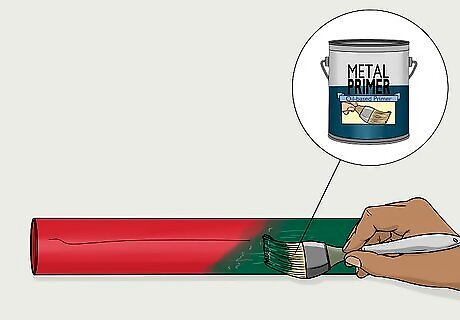
Apply a metal primer from top to bottom on the pipe. The easiest way to apply primer is with a microfiber foam roller with ⁄8 in (0.95 cm) nap. You could also use a 2 in (5.1 cm) stiff-bristled paint brush like you would on other surfaces. Pour the paint into a roller tray and add it gradually so it doesn’t drip. Then, cover the entire pipe in a consistent layer of paint from top to bottom. If you’re able to, work on pipes that haven’t been installed yet. Stand them up on a post or another object that allows you to reach both sides. Otherwise, paint the sides one at a time. For pre-installed pipes, spread a liquid primer and paint with a brush to cover tight areas. Work slowly to avoid getting the paint on nearby walls. If you’re able to, remove the pipe so you can see what you’re doing. If you’re using a spray-on primer, hold the canister about 6 in (15 cm) away from the pipe. Sweep it from side to side while gradually moving down, taking care not to overlap the primer. If you’re only able to paint one side of the pipe right away, paint it and let it dry. Once it is dry, you can flip it over and get the other side.
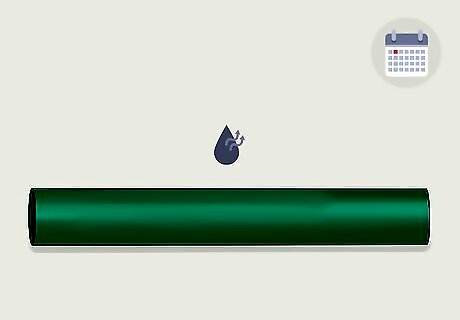
Wait about 24 hours for the primer to dry. Oil-based products dry at a relatively slow rate, so you’re going to have to deal with a bit of a wait. In the meantime, keep the pipe safe from moisture or anything else that could damage the finish. If you’re able to, place it in an area with plenty of air circulation. Make sure the primer is dry to the touch before attempting to paint over it. If it doesn’t cure properly, the paint won’t stick very well to the metal.
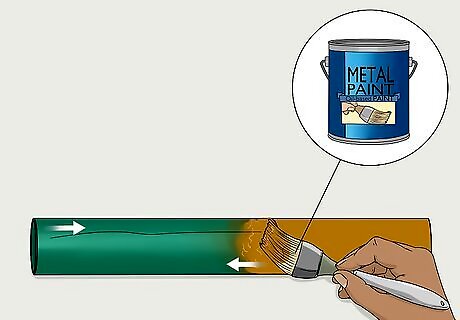
Coat the top edge of the pipe first and gradually work toward the bottom. Get a clean roller or brush to finish the pipe with liquid paint. Otherwise, use a metal spray paint to begin covering the pipe from top to bottom. If you are able to, work all the way around it before spreading paint to lower sections. Otherwise, paint the pipe one side at a time. Apply the paint consistently to avoid drips. If you notice drips, use less paint to compensate. Avoid overlapping any spots you have already painted.
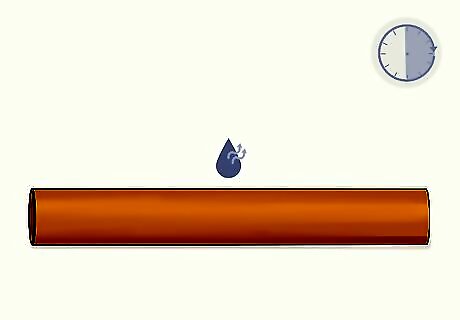
Allow the paint to dry for at least 6 hours. The drying time can vary a lot depending on the product you’re using. Some of them even take as long as 24 hours to surface dry, so check the manufacturer’s instructions for specifics. Wait for the paint to become dry to the touch before recoating the pipe. The paint has to dry, but it doesn’t have to fully cure. Metal paints tend to take a while to cure, so leave that until you’re completely finished painting.
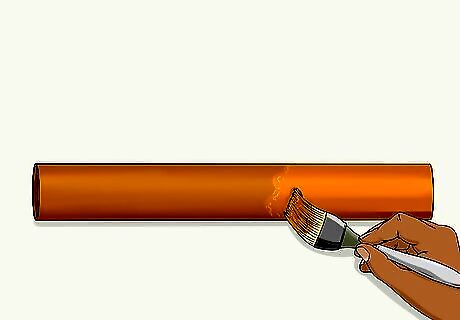
Repaint the pipe as needed, letting each layer dry in between. Expect the pipe to need at least one additional coat of paint for a quality finish. Add more paint sparingly to keep the second layer thin and identical to the first one. After it dries, check the quality. You can add multiple layers to even out the finish. Take care not to accidentally overlap any finished areas. For each layer, go over the pipe once. If you go over an area multiple times, the finish won’t be even. After you’re finished, give the pipe at least a day to finish drying before attempting to use it in a project. If it has already been installed, you don’t need to worry about it drying before you use it.




















Comments
0 comment